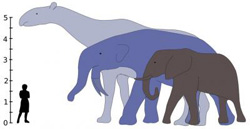Size of mammals exploded after dinosaur extinction

The largest land mammals that ever lived, Indricotherium and Deinotherium, would have towered over the living African elephant. The tallest on diagram, Indricotherium, an extinct rhino relative, lived during the Eocene to the Oligocene Epoch (37 to 23 million years ago) and reached a mass of 15,000 kg, while Deinotherium (an extinct proboscidean, related to modern elephants) was around from the late-Miocene until the early Pleistocene (8.5 to 2.7 million years ago) and weighed as much as 17,000 kg. Credit: Alison Boyer/Yale University<br>
Researchers demonstrate that the extinction of dinosaurs 65 million years ago made way for mammals to get bigger – about a thousand times bigger than they had been. The study, which is published in the prestigious journal Science, is the first to show this new pattern of increased body size of mammals after the exit of the dinosaurs.
“Basically, the dinosaurs disappear and all of a sudden there is nobody else eating the vegetation. That's an open food source and mammals start going for it, and it's more efficient to be an herbivore when you're big,” says paper co-author Dr. Jessica Theodor, associate professor in the Department of Biological Sciences at the University of Calgary.
Theodor says as well as confirming the dramatic growth in mammalian size after the dinosaurs, the study shows that the ecosystem is able to reset itself relatively quickly.
“You lose dinosaurs 65 million years ago, and within 25 million years the system is reset to a new maximum for the animals that are there in terms of body size. That's actually a pretty short time frame, geologically speaking,” she says. “That's really rapid evolution.”
Theodor says mammals grew from a maximum of about 10 kilograms when they were sharing the earth with dinosaurs to a maximum of 17 tonnes afterwards.
“Nobody has ever demonstrated that this pattern is really there. People have talked about it but nobody has ever gone back and done the math,” says Theodor one of the 20 researchers from around the world who worked on the study. “We went through every time period and said OK, for this group of mammals what's the biggest one? And then we estimated its body mass.”
In order to document how big mammals grew after the 'competitive release' caused by the extinction of dinosaurs, researchers collected data on the maximum size for major groups of land mammals on each continent, including Perissodactyla, odd-toed ungulates such as horses and rhinos; Proboscidea, which includes elephants, mammoth and mastodon; Xenarthra, the anteaters, tree sloths, and armadillos; as well as a number of other extinct groups.
The results give clues as to what sets the limits on mammal size on land; the amount of space available to each animal and the climate they live in. The colder the climate, the bigger the mammals seem to get, as bigger animals conserve heat better. It also shows that no one group of mammals dominates the largest size class – the absolute largest mammal belongs to different groups over time and space.
Media Contact
More Information:
http://www.ucalgary.caAll latest news from the category: Earth Sciences
Earth Sciences (also referred to as Geosciences), which deals with basic issues surrounding our planet, plays a vital role in the area of energy and raw materials supply.
Earth Sciences comprises subjects such as geology, geography, geological informatics, paleontology, mineralogy, petrography, crystallography, geophysics, geodesy, glaciology, cartography, photogrammetry, meteorology and seismology, early-warning systems, earthquake research and polar research.
Newest articles

Sea slugs inspire highly stretchable biomedical sensor
USC Viterbi School of Engineering researcher Hangbo Zhao presents findings on highly stretchable and customizable microneedles for application in fields including neuroscience, tissue engineering, and wearable bioelectronics. The revolution in…

Twisting and binding matter waves with photons in a cavity
Precisely measuring the energy states of individual atoms has been a historical challenge for physicists due to atomic recoil. When an atom interacts with a photon, the atom “recoils” in…

Nanotubes, nanoparticles, and antibodies detect tiny amounts of fentanyl
New sensor is six orders of magnitude more sensitive than the next best thing. A research team at Pitt led by Alexander Star, a chemistry professor in the Kenneth P. Dietrich…





















